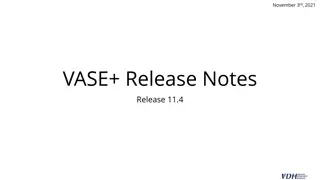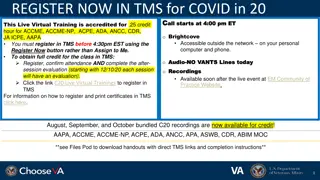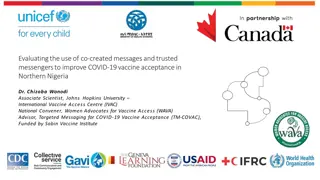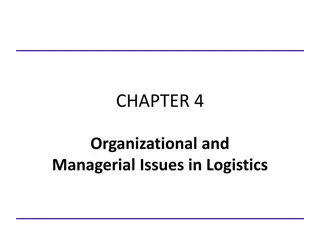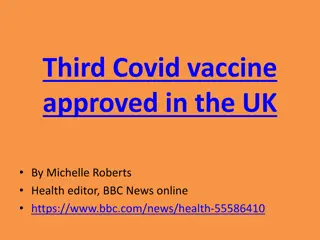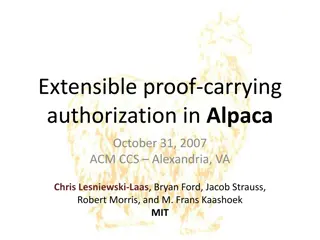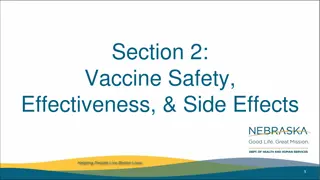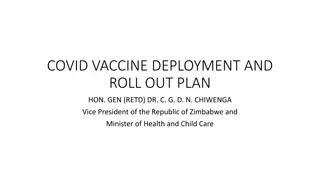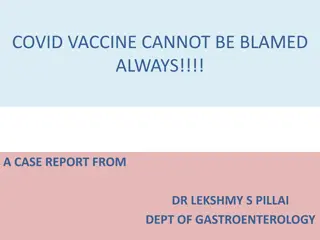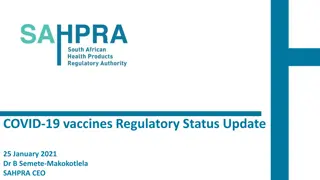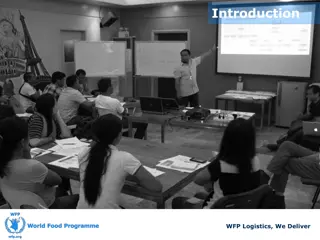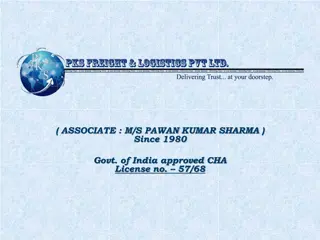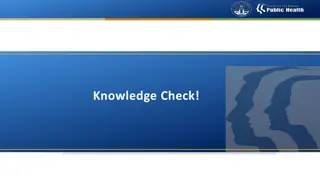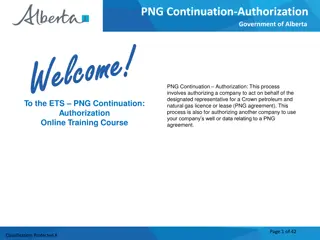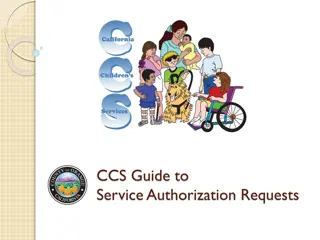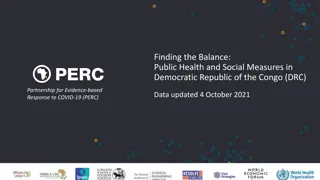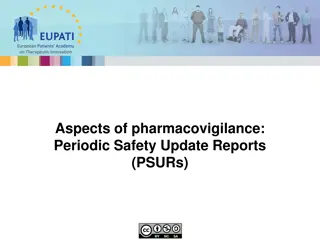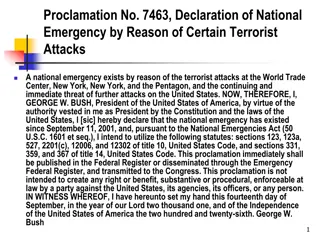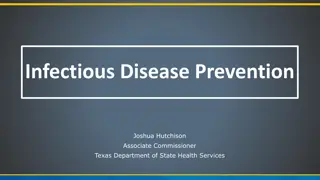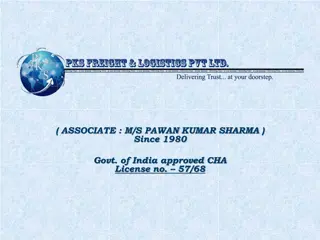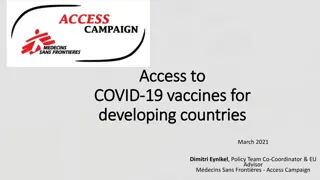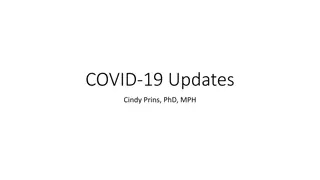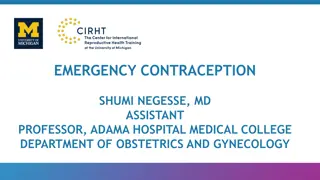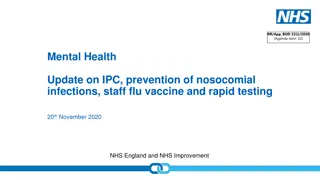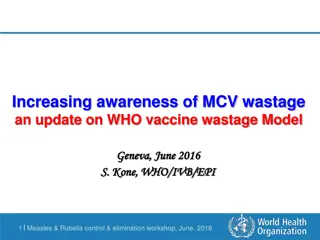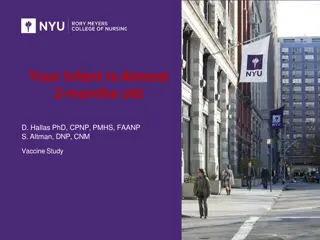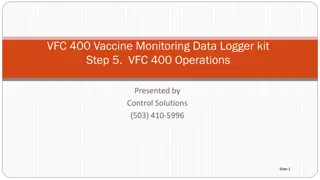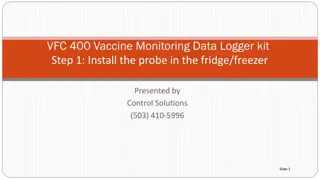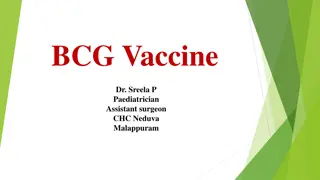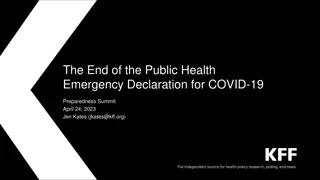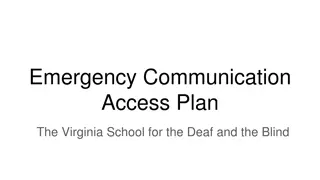COVID-19 Vaccine Update: Pfizer Vaccine Logistics and Emergency Use Authorization
The update discusses the latest information on Pfizer's COVID-19 vaccine, including details on the new technology, storage requirements, logistics handling, and Emergency Use Authorization (EUA). Pfizer's vaccine, with a 95% efficacy rate, requires storage in ultra-low-temperature freezers or thermal shippers with dry ice refills. It highlights the importance of EUA approval, the distribution process, and training for healthcare professionals. The content emphasizes the need to maintain the cold chain for vaccine storage and outlines the key considerations for handling and administering the vaccine effectively.
Download Presentation

Please find below an Image/Link to download the presentation.
The content on the website is provided AS IS for your information and personal use only. It may not be sold, licensed, or shared on other websites without obtaining consent from the author. Download presentation by click this link. If you encounter any issues during the download, it is possible that the publisher has removed the file from their server.
E N D
Presentation Transcript
COVID-19 Vaccine Update Jane Kelly, MD Assistant State Epidemiologist SC DHEC December 10 2020
Pfizer New technology, store at -70 2 injections 21 days apart Phase 3 study in 42,000 people o 95% efficacious: 170 w/symptoms & tested positive for COVID o 162 placebo (9 severe disease), 8 vaccine (1 severe) o Immunity 7 days after 2nd dose (28 days after initiate vaccine) No serious adverse events, but more than half had fatigue, chills, headache, muscle aches after 2nd dose Mild-moderate pain at the injection site in almost all Likely authorized for emergency use after FDA and ACIP reviews 12/11/2020 Special requirements to maintain cold chain https://www.nejm.org/doi/full/10.1056/NEJMoa2027906?query=featured_coronavirus
Pfizer vaccine logistics Training on the logistics handling of Pfizer vaccine cannot be sent out until EUA is approved. When EUA approved, DHEC will send handling information as soon as we are cleared to send it, as early as this week Videos on how to handle the vaccines. Information on the Pfizer webpage
Pfizer vaccine logisitics Vaccine sent via a thermal shipper Three options for storage: Ultra-low-temperature freezers Pfizer thermal shippers can be used as temporary storage units by refilling with dry ice every five days for up to 30 days of storage. Refrigeration units that are commonly available in hospitals Once thawed, vaccine can be stored for five days at refrigerated 2-8 C conditions
Emergency Use Authorization (EUA) EUA issued only after safety and efficacy standards are met Determination that the known and potential benefits of the investigational product outweigh its known and potential risks Use of an investigational vaccine under an EUA is not subject to informed consent requirements; rather a Fact Sheet is provided
Vaccine Allocation CDC has indicated SC s anticipated allocation will be ~200,000 to 300,000 doses by the end 2020 Those amounts are subject to change We won't know exact amount until doses received Current plan is weekly shipments as manufacturing increases DHEC and the Vaccine Advisory Committee have draft plans for vaccine allocation for 1a and later phases Awaiting opportunity to review the ACIP recommendations on Dec. 11, 2020 before finalizing plans for Phase 1b, 2 and 3
Phase 1a Vaccination ACIP recommendations: Health care personnel defined as paid and unpaid persons serving in health care settings who have the potential for direct or indirect exposure to patients or infectious materials Initial supply of vaccine will be limited; sub- prioritization is necessary DHEC recommends vaccinating frontline workers in a healthcare setting that are at highest risk of contracting COVID-19 and who are essential to preventing mortality among confirmed COVID-19 cases Protecting the individual workers but also protecting the health care system
Phase 1a Vaccination Persons performing direct medical care to suspected and/or confirmed COVID-19 patients Ancillary staff directly interacting with suspected and/or confirmed COVID-19 patients Emergency room staff at high risk of exposure to suspected and/or confirmed COVID-19 patients Paid and volunteer medical first responders (EMS, paramedics, fire department personnel who provide emergency medical services) and hospital transport personnel in direct contact with suspected and/or confirmed COVID-19 patients
Phase 1a Vaccination Persons providing direct medical care in Correctional facilities Dialysis and infusion centers Outpatient medical settings treating persons with suspected or confirmed COVID-19 infection Settings where monoclonal antibodies for COVID-19 infusions were given Home health and Hospice workers
Phase 1a Vaccination Residents and staff in long-term care facilities vaccinated through federal/pharmacy partnership DHEC will provide guidance on sub-prioritization of HCP when vaccine supply is limited initially Guidance on scheduling to avoid potential clustering of worker absenteeism related to systemic reactions associated especially with the 2nd dose of vaccine DHEC will not require vaccination though individual facilities may as a condition for employment (similar to influenza vaccine)
Safety and Reactogenicity Decision to vaccinate weighs benefit and risk Generally, want to minimize reactogenicity o Public perception of flu from influenza vaccine (i.e., innate immune response) Sometimes a reactogenic vaccine is better o New shingles vaccine (97% vs 51%) Patient s perceived benefit vs. risk impacts willingness to receive vaccine
What symptoms may occur? Moderna and Pfizer vaccines (Results from limited number of people from Phase 1/2 studies) No serious adverse events Fewer and milder symptoms with the 1st dose than 2nd More than half had mild-moderate fatigue, chills, headache, muscle aches after 2nd dose Mild-moderate pain at the injection site 1st dose ~60-80% mild 10% moderate 2nd dose ~60-75% mild, up to 25% moderate) Up to 3% severe headache, up to 2% severe fatigue after 2nd dose https://www.nejm.org/doi/full/10.1056/NEJMoa2022483?query=recirc_mostViewed_railB_article
Discussing the facts around vaccine including side effects You, as a health care professional, are a trusted voice People need to know ahead of time about possible local and systemic symptoms (so they are not surprised!) Avoid the term side effects Use temporary symptoms Explain the symptoms are a sign that the vaccine is working; the immune system is responding
What should I tell people? Severe symptoms are rare, but mild-moderate ones are common, with the COVID-19 vaccines Consider the shingles vaccine analogy Which would you prefer: the old shingles vaccine that causes fewer symptoms but only works half the time, or the new one that is 97% efficacious but may give you fever, myalgias, and fatigue for a couple of days? Risks of vaccine vs. risk of COVID-19 disease Don t forget you can take acetaminophen Workers might consider getting vaccinated when they have 1-2 days off following vaccination, especially after the second dose
What about long-term or rare side effects? Might not know about rare or long-term side effects until millions are vaccinated FDA and CDC will collect safety data from those vaccinated Will also have safety data from other countries (e.g., England) Each of us must weigh risk/benefit ratio: Benefit of vaccine (with 95% efficacy) protecting from COVID-19 nowvs. Symptoms with vaccination and unknown rare or long- term risks
Contraindications to COVID-19 vaccine? In the US, severe allergic reaction in ~ one of every 1.4 million doses of vaccine 2 severe allergic reactions thus far in the UK Persons with significant allergic reaction to a vaccine, medicine or food (e.g., history of anaphylactoid reaction or those who have been advised to carry an adrenaline autoinjector) should be cautioned o Awaiting FDA/ACIP recommendations o May suggest wait for a different vaccine platform o Have epinephrine and resuscitation capability available
Safety in Pregnancy Pregnant women are excluded from vaccine trials mRNA vaccine do not contain a live virus but rather induce humoral and cellular immune response through the use of viral mRNA The theoretical risk of fetal harm from mRNA vaccines is very low As data emerge, counseling will likely shift, as some vaccines (e.g., AstraZeneca adenovirus vector) may be more suitable for pregnant women The Society for Fetal and Maternal Medicine recommends that healthcare workers, who are considered prioritized for vaccination, be offered the vaccine if pregnant https://www.smfm.org/covidclinical
Institute for Health Metrics and Evaluation, SC, 12.06.2020
frontline workers in medical settings at highest risk for COVID-19 Vaccines don t save lives; vaccinations do! Timeline not definite USG contracted for 100M doses from each company CDC has indicated SC allocation will be ~200K-300K doses by the end of 2020 (subject to change) We won t know exact amount until doses are received DHEC anticipates this will be enough for medical first responders, frontline workers in medical settings at highest risk for COVID-19, residents/staff in LTCF Need to stagger vaccinations (don t vaccinate entire team at same time!), and not everyone in the first week As more vaccine becomes available early 2021, will expand vaccination program
Do I need to save and store the 2nd dose? No example Pfizer vaccine 1st week week week after 1st week) 3rd 4th week (21 days 5th week (21 days after 2nd week) 2nd 1000 doses 200 doses 200 doses 200 doses + 1000 booster for Week 1 200 doses + 200 booster for Week 2
Preventing disease vs. Preventing infection IPV OPV
COVID-19 Vaccine Questions Are the mRNA vaccines like IPV or OPV? Reduce infection and transmission or reduce symptomatic disease only? In HIV terms, U = U (undetectable = untransmittable) Does vaccinating me protect you? Do I have to wear a mask after vaccination? o Yes! Until we find out if V = U or we have a vast majority vaccinated Safe in immunocompromised? Organ transplant patients?
Active safety follow-up (in addition to VAERS)
Questions? kellyjm1@dhec.sc.gov scdhec.gov/covid19 cdc.gov/covid19


